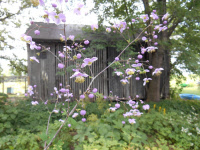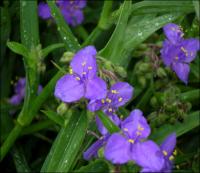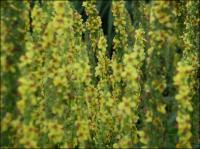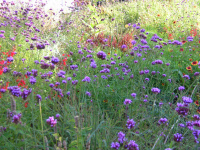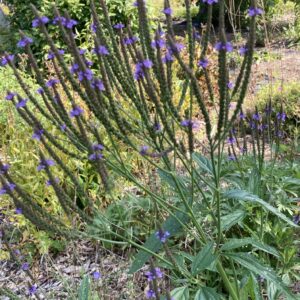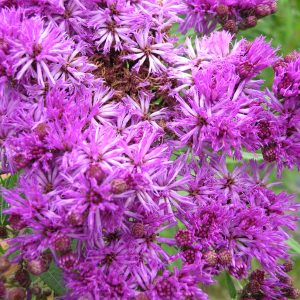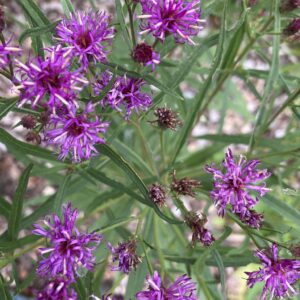Plants for Butterflies and Other Pollinators
Showing 193–200 of 211 results
-
Thalictrum rochebruneanum Lavender mist meadowrue Z 4-7
Lacy, fine-textured, bluish-green, pinnately compound, columbine-like foliage topped by pendulous, lavender-purple flowers (sepals) with yellow stamens July-September in airy clusters rising well above the foliage to 4-6' tall. Extraordinary en mass. One of internationally known garden designer Piet Oudolf's 100 "MUST HAVE" plants, Gardens Illustrated.
Lacy, fine-textured, bluish-green, pinnately compound, columbine-like foliage topped by pendulous, lavender-purple flowers (sepals) with yellow stamens July-September in airy clusters rising well above the foliage to 4-6′ tall. Extraordinary en mass. One of internationally known garden designer Piet Oudolf’s 100 “MUST HAVE” plants, Gardens Illustrated.
Size: 6’ x 30”
Care: sun to part shade in moist well-drained soil
Native: Japan
Wildlife Value: Attracts Black swallowtail butterfly
Awards: Missouri Botanic Garden Plant of MeritThalictrum is from Greek meaning “to flourish” or “look green.” This species collected before 1878. Likely named for French botanist Alphonse Trémeau de Rochebrune (1834-1912).
-
Tradescantia bracteata Spiderwort Z 4-9
Three-petaled rosy purple petals frame bright yellow stamens, open mornings and close by noon from June-August. Cut back for rebloom.
Three-petaled rosy purple petals frame bright yellow stamens, open mornings and close by noon from June-August. Cut back for rebloom.
Size: 12-18” x 12”
Care: full sun to part shade in moist well drained soil
Native: Minnesota south to Texas - Wisconsin native
Wildlife Value: attracts bees & butterfliesEnglish herbalist John Parkinson (1567-1650) named the Genus after John Tradescant the Younger who sent Tradescantia virginiana it to his father, gardener to Kings James III and Charles I. This prairie plant collected before 1938.
-
Tradescantia virginiana Spiderwort Z 4-9
Purple umbels of three petals with prominent yellow stamens June – October, opening in the morning and closing at noon.
Purple umbels of three petals with prominent yellow stamens June – October, opening in the morning and closing at noon.
Size: 18-24" x 24"
Care: Full sun to part shade in moist to moist well-drained soil
Native: From New York to South Dakota, Virginia and Arkansas and all states in between. Wisconsin native.
Wildlife Value: Bumblebees and honeybees eat the nectar and collect the pollen.Named after John Tradescant, an English botanist and gardener to Kings James III and Charles I. Parkinson (1567-1650) explains the origin of this plant: “This Spider-wort is of late knowledge, and for it the Christian world is indebted unto that painfull industrious searcher, and lover of all natures varieties, John Tradescant who first received it of a friend, that brought it out of Virginia,” (1639). It was probably sent to mainland Europe in 1500’s. Grown at America’s 1st botanic garden, Elgin Botanic Garden 1811. Tradescantia was cherished by the Dakota Indians for its beauty. Cherokee ate the young greens and prescribed it to cure stomachaches after overeating, female illnesses, cancer, and insect bites. Menominee revived those “defiled by touch of bereaved.” Natives applied a poltice of the leaves topically for insect bites and stings. By 1659 ones with white, light blue and reddish flowers grown in England. According to Monticello.org the root exuded a gummy liquid which, when inserted into a cut on top of a person’s head remedied the person’s “craziness.”
-
Verbascum nigrum Dark mullein Self-seeding biennial Z 4-9
June to October (if deadheaded) 3’ fall spikes covered with five-petal flowers of canary yellow, spotlighting purple stamens at each flower’s center.
June to October (if deadheaded) 3’ fall spikes covered with five-petal flowers of canary yellow, spotlighting purple stamens at each flower’s center.
Size: 36" x 24"
Care: Sun well-drained soil - self-seeder
Native: Europe to SiberiaVerbascum was named by the Roman Pliny who said they attracted moths, calling them Moth mulleins. Cultivated in gardens as long ago as Medieval times. Favorite plant in Elizabethan cottage gardens in the 1500’s. Grown in the Eichstätt Garden, the garden of Johann Konrad von Gemmingen, prince bishop of Eichstätt in Bavaria, c. 1600. Described by Parkinson in 1629 as: “a stalke whereon stand many golden flowers with the like purple threads in the middle.”
-
Verbena bonariensis Perennial Z 7-10, colder zones-reseeding annual
Small purple flowers atop tall leafless stems from July to October. Great see-through blooms for growing in back, middle or front of the garden.
Small purple flowers atop tall leafless stems from July to October. Great see-through blooms for growing in back, middle or front of the garden.
Size: 3-4’ x 8”
Care: full sun in moist, well-drained, fertile soil - self-seeder
Native: South America
Awards: Royal Horticultural Society Award of Merit & Missouri Botanic Garden Plant of Merit.Introduced to garden cultivation from its native Buenos Aires in 1726 by the Sherard brothers.
-
Verbena hastata Blue vervain, Simpler’s joy Z 3-9
Bright purplish-blue candelabra-like spikes from July to September
Bright purplish-blue candelabra-like spikes from July to September
Size: 2-4’ x 2’
Care: sun to part shade in moist or moist well-drained soil
Native: eastern 2/3rds of No. America, Wisconsin native
Wildlife Value: Cardinals & Sparrows eat the seeds. Food for larvae of Buckeye butterfly.Native Americans used plant as remedy for coughs, colds, and fever. Mahuna Indians of So. California used the root to cure complicated stomach fevers. Sioux fed the seeds to their horses to give them energy. The Sioux also used it as an insect repellant. Pressed specimen in Emily Dickinson’s herbarium.
-
Vernonia fasciculata Prairie Ironweed Z 3-7
Dense clusters of fluffy petaled, true royal purple flowers atop unbranched stems, July-September
Dense clusters of fluffy petaled, true royal purple flowers atop unbranched stems, July-September
Size: 3-4’ x 2-3’
Care: sun to part shade in moist to moist well drained soil
Native: so central Canada to central & eastern US, Wisconsin native
Wildlife Value: Butterfly attractor – Fiery skipper. Host for Common buckeye butterfly. Deer & rabbit resistant.Lakota Sioux: “The leaves are formed into a sort of “plate” that keeps foreign matter from getting on meat. An infusion of the root is used to regulate menstrual periods.”
Collected by French planthunter André Michaux (1746-1802) who spent 11 years exploring America for plants. Vernonia named to honor Wm. Vernon (1666-1711) English botanist who collected plants in late 1600’s. -
Vernonia lettermannii Threadleaf ironweed Z 4-9
Deep purple inch-wide flower heads top unbranched stems forming a dome in late summer-early fall
Deep purple inch-wide flower heads top unbranched stems forming a dome in late summer-early fall
Size: 4-5’ x 36”
Care: sun in well-drained to moist well-drained soil
Native: Arkansas and OK
Wildlife Value: attracts numerous butterflies and pollen source for bees, deer resistant
Awards: Pennsylvania Horticultural Society Gold Medal 2023Collected on “Cooper’s Creek by Dr. J.M. Bigelow and on the sandbars of the Washita,.” Proc. Amer. Acad. Arts xvi. (1881) 78. 78 1880. “Notes on Some Compositae.” Vernonia named to honor Wm. Vernon (1666-1711) English botanist who collected plants in Maryland in late 1600’s. The species named to honor George Lettermann (1840-1913) who was primarily interested in trees and, while working for the US Census, collected tree specimens in forests of Missouri, Arkansas, western Louisiana and eastern Texas.

